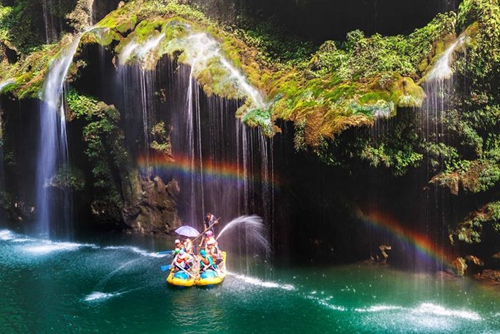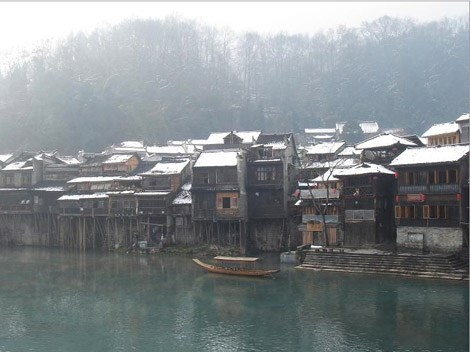-

The 112-kilometer-long river originates in Longshan County. In the lower reaches, it joins You River, and goes into Yuan River. It was named Mengdong River after the hole in its sources in Mengbi Vally in Longshan County. Nowadays, the Mengdong River scenic spot is famous largely as an ideal place for rafting. Here visitors can raft on it in rubber boats, and because of the fantastic scenery and unforgettable experience, it gains the praise as the \"number one rafting in the world\".Mengdong River is one of the sources of the culture of Tujia nationality. One can know more about the history, culture and customs of Tujia nationality by visiting the Old Town of Wang Valley,Tujia History Museum, Tujia Custom Museum. At the same time, one can take part in various cultural activities.Transport: Visitors can take a taxi from Wangcun Town to reach hereTel: (86)743-5853367.Admission (for reference): RMB168 yuan/adult:Opening hours: 08:00 -18:00
Xiangxi & Fenghuang & Huaihua
2012-04-11 16:45
View:4808
-

Man La River—The Jasper from HeavenHave you ever joined in outdoor adventure? Do you prefer to prime hiking, rock climbing and stunning scenic spots? Are you bold enough to experience a fantastic traveling? If yes, then, there has a better choice to serve all your needs—Man La River.Man La River, adjacent to gorge, is located in the churchyard of Yangfeng village in Yongshun county of Xiangxi autonomous. Precipitous cliffs tower into the blue sky, as if to vying with heaven in stature. Craggy rocks on both sides of the cliffs shape various forms and teeming plants scatter there and here in clusters. Up the rocks, over the cliffs and across the brooks, you come to the valley. There are numerous lakes with different sizes. Limpid and fresh water wavers as gentle breeze brushes through, overlooking from the sky like jaspers inlayed in the crown. The cliffs, lakes and valley may give you a sense that it is easy to hike and climb these obstacles, but when you go deeper, the valley becomes narrower, in some place even only to allow one person past. So be careful lest you may encounter accidents. The most exciting and amazing part that you can not miss are the waterfalls. Two impetuous waterfalls gallop with all mighty down from steep cliffs to the lake and the splashing water knits a net of reverie as if where all the amazing things can happen.If you are indulged in the nature, especially in outdoor adventures, Man La River is a destination that will not let you down. Don not hesitate, call your friend and start an extraordinary journey!By Crystal#gallery-1 {margin: auto;}#gallery-1 .gallery-item {float: left;margin-top: 10px;text-align: center;width: 33%;}#gallery-1 img {border: 2px solid #cfcfcf;}#gallery-1 .gallery-caption {margin-left: 0;}
Xiangxi & Fenghuang & Huaihua
2012-04-04 23:31
View:3096
-
![Romantic Phoenix Town[Photo Gallery]](/attachments/2011/10/1_201110251535361AAN3.jpg)
Romantic Phoenix Town
Xiangxi & Fenghuang & Huaihua
2011-10-25 15:34
View:7773
-

Xiangxi Liye Town–Stepping to Mysterious Western Hunan
“Liye” means developing this land in Tujia language. Liye town is the hometown of the slips of Qin Dynasty.Located in the back-land of Hunan Wuling Mountain, Liye belongs to Longshan County, Tujia-Miao autonomous prefecture of Western Hunan. Together with WangVillage, Pu City and Cha Dong, these four places are called four ancient towns inWestern Hunan. Dating back to 6000 years ago, habitants have already started to live in Liye. Thus, Magical natural landscape and unique folk custom are formed as time goes by.Liye is rich in natural resources and cultural heritage. It can be regarded as a natural museum of various historical relics. Liye is the unique place in Hunan province that not only inherits Qin-Han culture, but also mixes Ba-Shu culture with Tujia culture. And Liye is the birthplace of Tujia nationality. That’s to say, it has a long history and abundant folk culture.Translated by Becky
Xiangxi & Fenghuang & Huaihua
2011-04-06 22:08
View:3465
-

The stilt house (Diaojiao House), a kind of folk residence built on the stilts of different heights, is usually built beside the river or in steep mountain areas. The stilt house is usually divided into two parts, the front part and the rear part. The front part is a storied building built on the ground and similar to the fence-style building, while the rear part is a bungalow. In front of the house is a corridor formed by wood balusters with a height of about 1 meter. Suspended windows were equipped in some houses for rest and enjoying cool. Sundries can be stored under the floor, and, by this, the space is utilized smartly. The space of the stilt house is arranged facilely in various shapes. The shortage of construction land is relatively relieved, for the stilt house makes use of the hillside or river, which is originally not suitable for building houses. Furthermore, it has the advantages of aeration, moisture-proof, viper defense, and wild animal defense.The west area of Hunan Province of China is a mountainous area in which many ethnic groups live, including Han, Tujia, Miao, Hui, Yao, Dong, Zhuang, etc. In this area, the chain of mountains runs up and down, rivers densely distributed, and trees abundant. The unique geographic environment, together with the condition that many ethnic groups live here, has given birth to the Xiangxi (the west area of Hunan Province) stilt house which is unique, elegant, close to rivers and mountains, and abundant in trees.The integration of cultures of various ethnic groups has endowed the Xiangxi stilt house with rich and diversified cultural connotations. For example, the stilt house of Tujia ethnic minority embodies the universal view of the coexistence of human and God. And the Dong people like to beautify the environment through such measures as carving the chapiters of the house into bamboo shape, and carving flower patterns on the banisters of the corridor. Moreover, the stilt houses of other ethnic minorities have their own distinctive features.
Xiangxi & Fenghuang & Huaihua
2010-11-30 18:07
View:6607


![Romantic Phoenix Town[Photo Gallery]](/attachments/2011/10/1_201110251535361AAN3.jpg)






